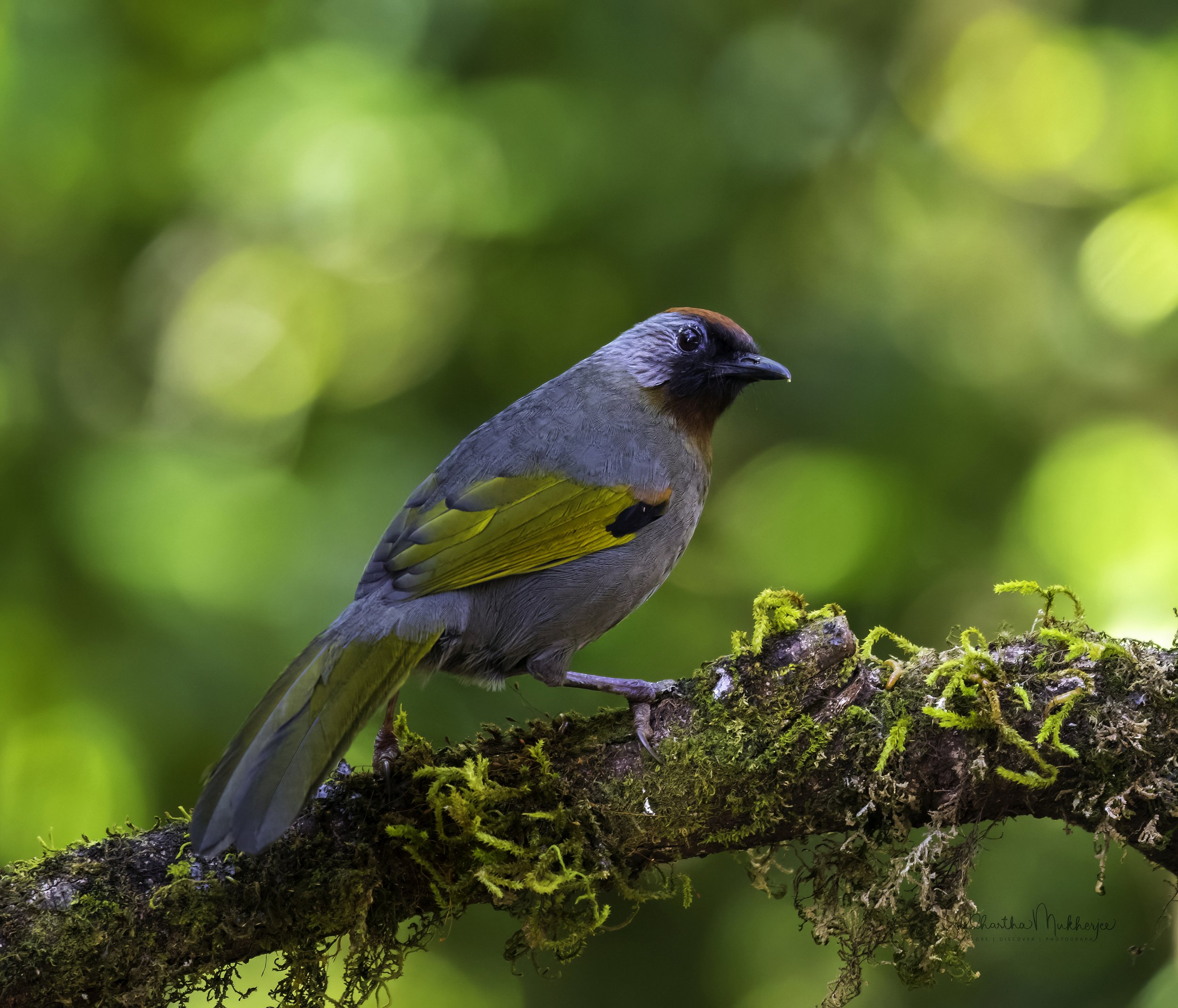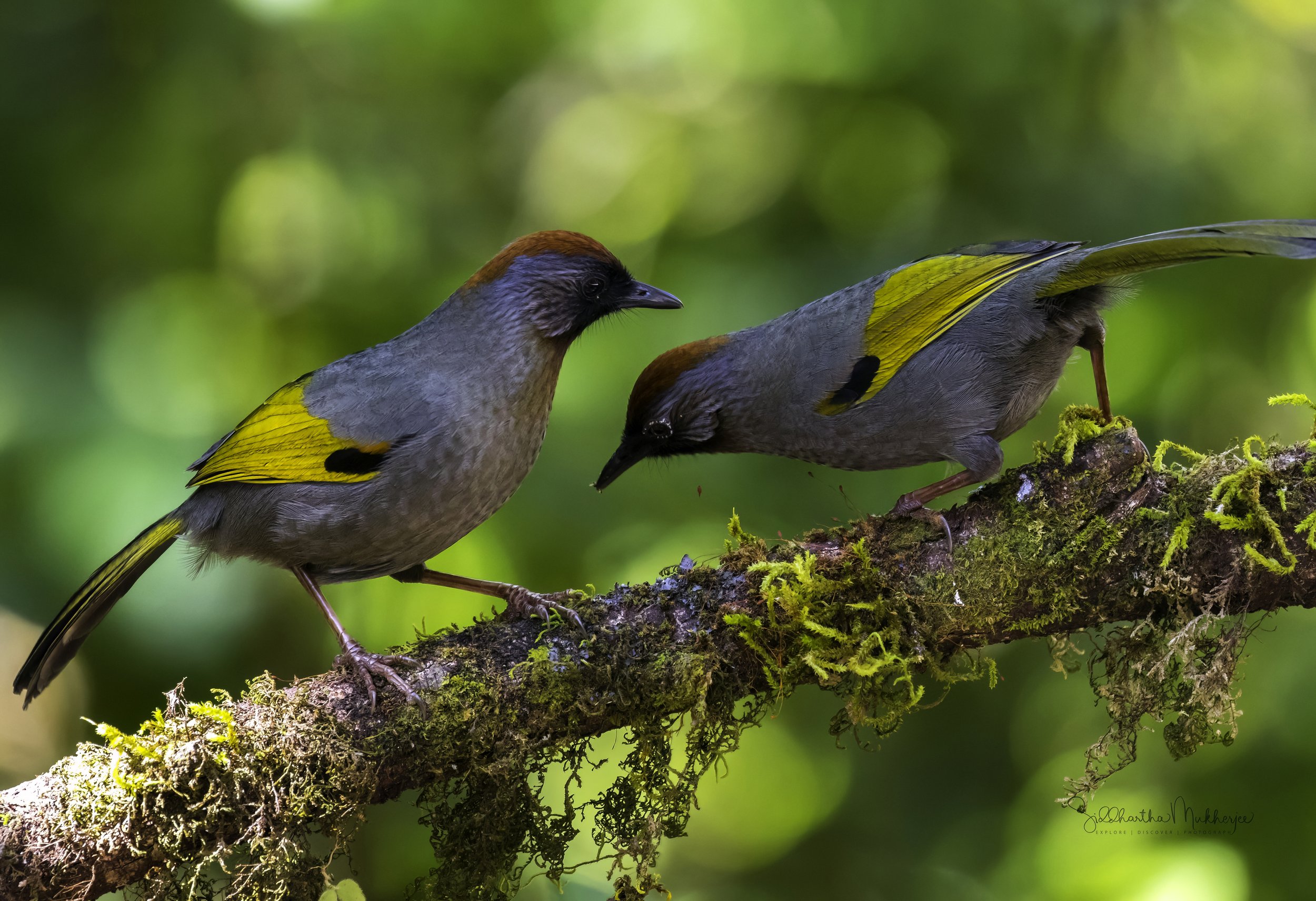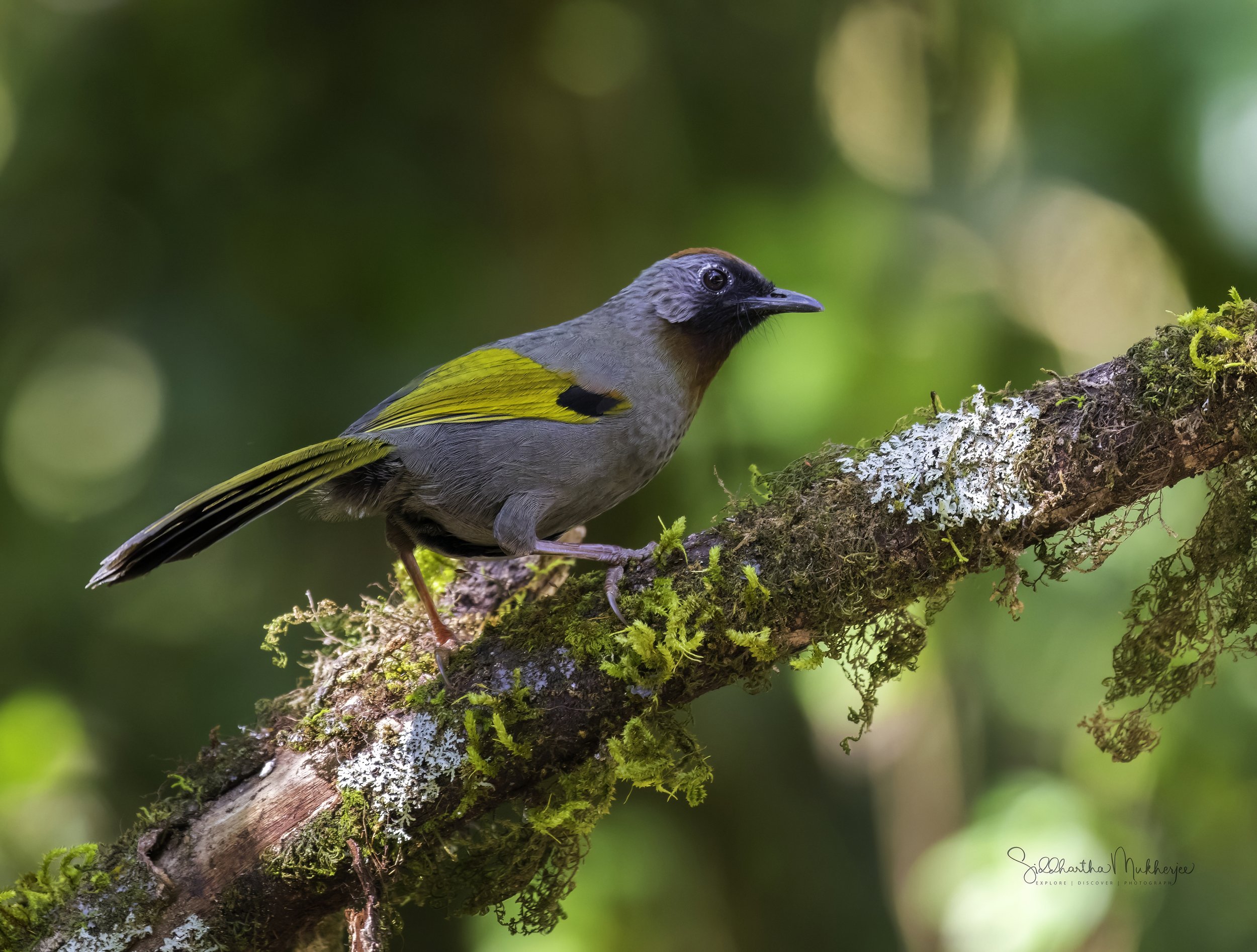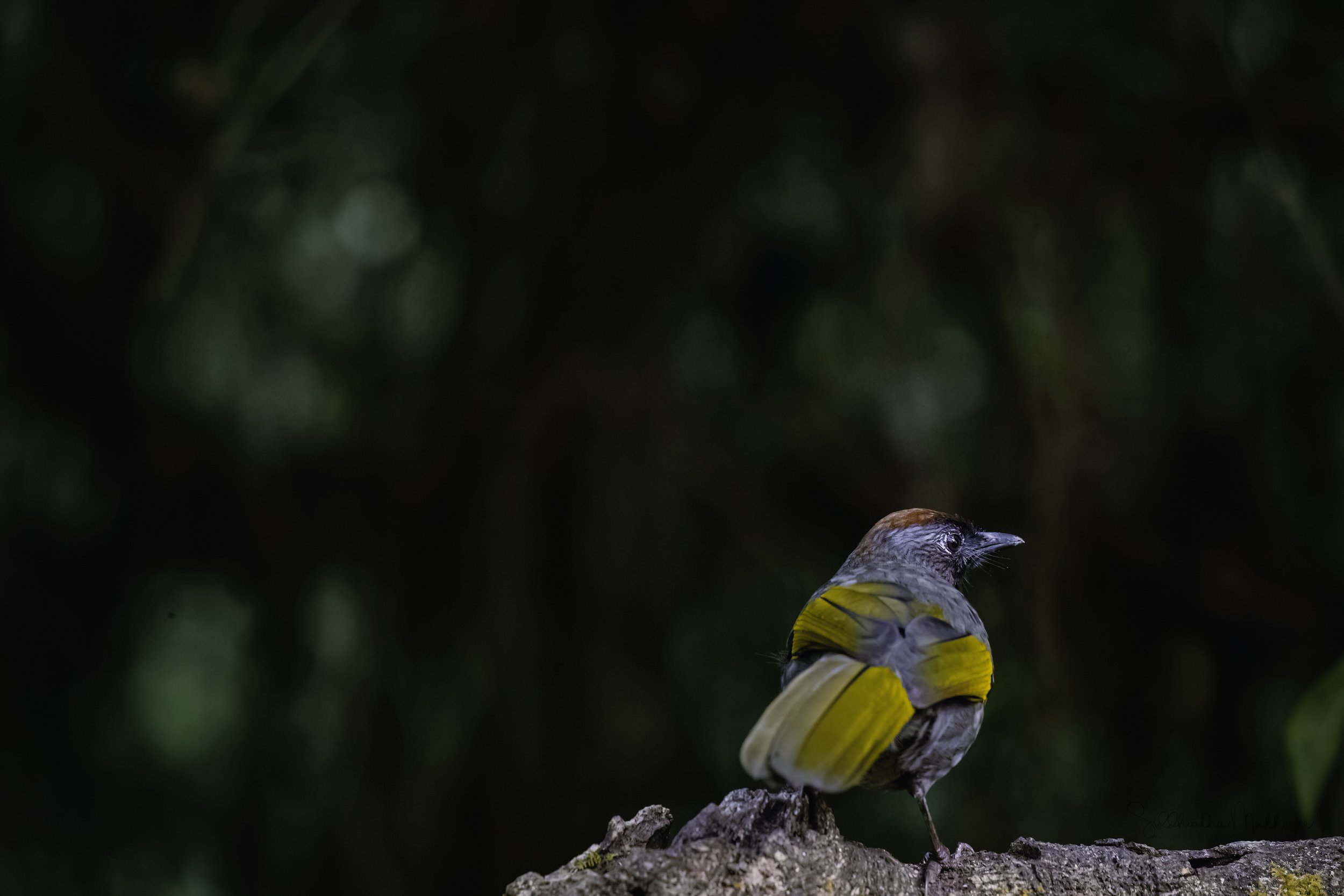Silver-eared Laughingthrush
Trochalopteron melanostigma
Doi Luang, Chiang Mai, Thailand
The laughingthrushes are also a family of Old World passerine birds diverse in size and coloration. These are birds of tropical areas, with the greatest variety in Southeast Asia and the Indian subcontinent. The entire family used to be included in the Timaliidae.
These laughingthrushes are small to medium-sized birds with strong legs, and many are quite terrestrial. They typically have generalised bills, similar to those of a thrush. Most have predominantly brown plumage, with minimal difference between the sexes, but many more brightly coloured species also exist.
This group is not strongly migratory, and most species have short rounded wings, and a weak flight. They live in lightly wooded or scrubland environments, ranging from swamp to near-desert. They are primarily insectivorous, although many will also take berries, and the larger species will even eat small lizards and other vertebrates.
The family contains 133 species divided into 16 genera. I have written, in earlier blogs, about a few of the genera like the Spectacled Barwing, the Red-faced Liocichla, the Silver-eared Mesia, the Sibias and the Old World Babblers.
Today is another addition to this list with this beautiful Silver-eared Laughingthrush inhabiting the beautiful hillsides of North Thailand.
Leiothrichidae
The laughingthrushes are a family, Leiothrichidae, of Old World passerine birds. The family contains 133 species which are divided into 16 genera. They are diverse in size and coloration. These are birds of tropical areas, with the greatest variety in Southeast Asia and the Indian subcontinent. The entire family used to be included in the Old World babbler family Timaliidae.
They are small to medium-sized birds. They have strong legs, and many are quite terrestrial. They typically have generalised bills, similar to those of a thrush. Most have predominantly brown plumage, with minimal difference between the sexes, but many more brightly coloured species also exist.
This group is not strongly migratory, and most species have short rounded wings, and a weak flight. They live in lightly wooded or scrubland environments, ranging from swamp to near-desert. They are primarily insectivorous, although many will also take berries, and the larger species will even eat small lizards and other vertebrates.
The family Leiothrichidae was introduced (as a subfamily Leiotrichanae) by the English naturalist William Swainson in 1832. A comprehensive molecular phylogenetic study of the family published in 2018 led to substantial revision of the taxonomic classification. The laughingthrushes in the genus Garrulax were found to belong to three separate clades that had diverged in the Miocene 7-9 million year ago. The genus was therefore split with Garrulax restricted to one clade and the genera Pterorhinus and Ianthocincla resurrected for the other two clades. The genus Turdoides was also split and species moved into the resurrected genus Argya.
In a separate change, the crocias were moved to the genus Laniellus Swainson, 1832 which has priority over Crocias Temminck, 1836.
The family contains 133 species in 16 genera:
Grammatoptila – striated laughingthrush
Cutia – cutias (2 species)
Laniellus – crocias (2 species)
Trochalopteron – laughingthrushes (19 species)
Actinodura – barwings and minlas (9 species)
Montecincla – laughingthrushes (4 species)
Minla – red-tailed minla
Leioptila – rufous-backed sibia
Leiothrix – (2 species)
Liocichla - liocichlas (5 species)
Heterophasia - sibias (7 species)
Argya – mainly babblers (16 species) – previous placed in Turdoides
Turdoides – babblers (19 species)
Garrulax – laughingthrushes (14 species)
Ianthocincla – laughingthrushes (8 species) – previously placed in Garrulax
Pterorhinus – laughingthrushes and babaxes (23 species) – previously placed in Garrulax
The focus today is the gorgeous Silver-eared Laughingthrush but first a little bit about Chiang Mai.
The word Chiang itself is from North Thai, or Lanna, meaning town or city and Mai means new making Chiang Mai the New City as it was founded later than Chiang Rai, the earlier capital of King Meng Rai. The districts in the province are called amphoe, and sub-districts are called tambon. Another twist is the use of Nakhon (or Nakorn or Nakhorn), derived from the Sanskrit word Nagara, also means city, though strictly speaking it refers to a capital city such as Nakorn Sri Ayutthaya (more on Ayutthaya later). Indeed to emphasise its former status you may sometimes see Chiang Mai referred to as Nakhon Ping. Other common names of geographical features include mae (river) and doi which is north Thai for mountain - for example Doi Inthanon and Mae Ping.
Doi Luang
In close proximity to the Doi Pha Hom Pok National Park, it is the second highest mountain in Thailand and a part of the Dan Lao Mountain range, northwest of Chiang Mai, sharing the border with Myanmar. Doi Luang & Doi SanJu, can be easily accessed from Fang town. The mountain forest and no traffic make it easy to view birds. The entire area is very quiet, secluded and home to rare species like Mrs. Humes Pheasant, Long–tailed Sibia, Himalayan Cutia, Black–throated Tit, Black–eared Shrike Babbler, Whiskered Yuhina, Crimson–breasted Woodpecker, Fire–tailed Sunbird to name a few.
We didn’t have the good fortune to see all the species on all the mountains, that would have been impossible, but we did rack up quite a number of species - about 95 of them. This gallery is of the Silver-eared Laughingthrush.
Silver-eared Laughingthrush
The Silver-eared Laughingthrush (Trochalopteron melanostigma) is a species of bird in the family Leiothrichidae. An attractive medium-sized laughingthrush with a gray body, golden-yellow wings, dark face, and chestnut crown. Also note the dark orangish “bib”, the color of which varies by range; northern birds have the brightest patches. The namesake silver ear patches are rather rounded and blend smoothly into the gray of the neck. They are usually seen scratching around noisily in dense undergrowth, often singly, or in pairs or small flocks; and may come out into the open in areas where routinely fed and habituated to people. They inhabit montane and hill forests, as well as forest edges with dense low growth and are found in southern Yunnan, Laos, Myanmar, Thailand and Vietnam. It was formerly considered a subspecies of the chestnut-crowned laughingthrush, G. erythrocephalus.
The Silver-eared Laughingthrush is about 26 cm long and weighs between 67–75 g. It is a variable dark laughingthrush with silvery-edged ear-coverts. The nominate race has a chestnut crown and nape, the upperparts are a plain dark olive-tinged grey-brown, palest on the mantle and neck side; greater upper wing-coverts are a chestnut-washed brown, and primary coverts black, the flight-feather fringing and tail olive greyish-yellow; lores, frontal supercilium, cheek, malar and chin blackish, rear supercilium and ear-coverts dull silvery with maroon streaks; lower throat and upper breast dull maroon, rest of underparts dirty ochrous-olive, shading darker lower down and greyer towards sides; iris greyish to dark brownish-grey; bill dark brownish; legs fleshy-brown to dark purplish-grey, sometimes tinged yellowish. Differs from similar T. erythrocephalum and T. chrysopterum in unspotted back, dark primary coverts, more extensive silvery edges on ear-coverts, dark-streaked grey supercilium spreading to upper neck side, black chin and malar area, and olive-tinged lower underparts. The sexes are similar. The race ramsayi is like nominate, but has brighter greenish wing fringing, more extensive and brighter yellowish-tan on lower throat to belly; schistaceum is purer grey above and on belly, with very slight scaly effect on breast, blacker-tinged ear-coverts; subconnectens has dusky-brown ear-coverts with silvery edgings, tan-washed olive-grey breast and belly with scaly brownish-grey edges (creating distinct scaly effect); connectens resembles last, but scaly effect below even more pronounced, has yellowish-olive wing fringing (including primary coverts).
The following subspecies are recognised:
Trochalopteron melanostigma connectens - Distributed in S China (SE Yunnan), NE and C Laos and NW Vietnam (W Tonkin).
Trochalopteron melanostigma subconnectens - Distributed in N Thailand (Doi Phu Kha National Park) and NW Laos.
Trochalopteron melanostigma schistaceum - Distributed in extreme E Myanmar and NW Thailand (including Doi Chiang Dao and Doi Pha Hom Pok).
Trochalopteron melanostigma melanostigma - Distributed in SE Myanmar (including NE Tenasserim) and NW and W Thailand (S from Doi Inthanon).
Trochalopteron melanostigma ramsayi - Distributed in S Myanmar (C Tenasserim) and adjacent S Thailand.
These laughingthrush frequent broadleaf evergreen, pine and mixed broadleaf-pine forests, secondary growth, scrub and grass, bamboo brakes; at 1065–2565 m, but down to 610 m in S Myanmar (C Tenasserim). They feed presumably on invertebrates and some vegetable matter and are typically encountered when foraging singly, in pairs or in small groups, on or close to ground; occasionally ascends moss-cloaked and lichen-covered tree branches.
They are a generally common bird in their range, rare in Yunnan, in China. In Thailand, they are common in the Doi Chiang Dao Wildlife Sanctuary and Doi Inthanon and Doi Suthep-Pui National Parks. Common in Nakai-Nam Theun National Biodiversity Conservation Area, in Laos. Present in Pu Mat Nature Reserve and common in Fan Si Pan National Park, in Vietnam.
‡‡‡‡‡
This is but a glimpse into the beautiful world of the laughingthrushes and the tremendous variety in the species and that they are still being discovered. Do subscribe if you liked what you saw and if you would like to continue to read these insights into the beautiful birds and animals inhabiting our planet.
Related Posts





















